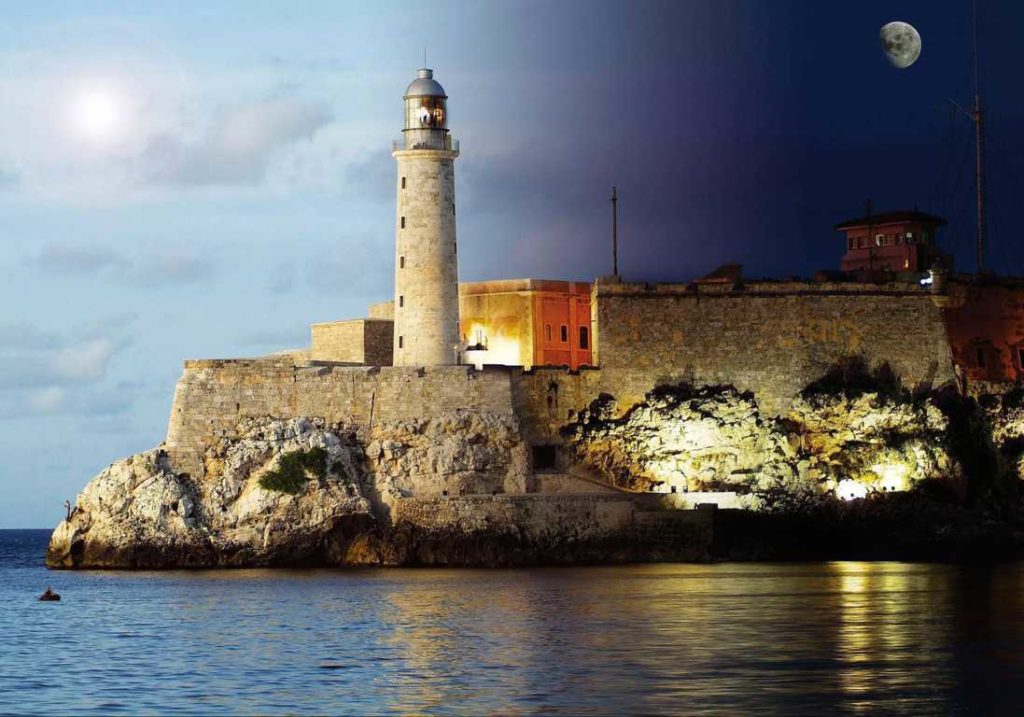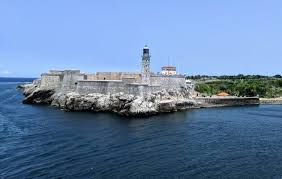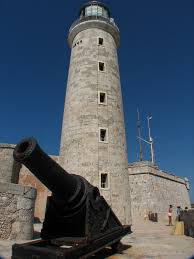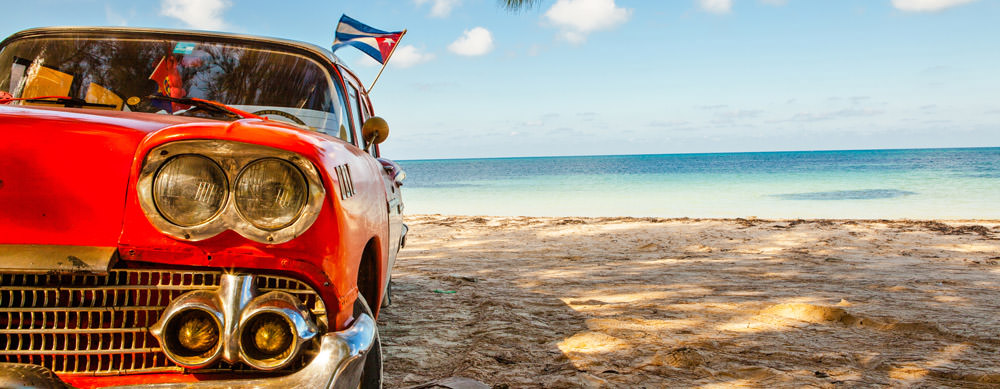LA TORRE Y FARO DEL CASTILLO DEL MORRO, LA HABANA CUMPLEN 175 AÑOS.
Al igual que la famosa estructura de la estatua de la Libertad a la entrada del puerto de Nueva York, en la Habana lo primero que ves cuando entras en su puerto es el Castillo del Morro y el Faro de su fortaleza.
Un reconocido símbolo de la capital cubana, el faro es un fiel vigía del acceso a la bahía del puerto habanero y terminó de construirse el 21 de junio de 1845.
Este vigía de la importante rada, está enclavado en las murallas del Castillo de los Tres Reyes Magos del Morro, antigua fortaleza española, posee un alcance de 18 millas náuticas y emite dos destellos de luz cada 15 segundos. Erigido de sillería y 45 metros de altura sobre el nivel del mar sustituyó al viejo faro de cal y canto que utilizaba leña como combustible.
Tiene dos cuerpos, el primero es de setenta y seis pies de alto y el resto está rematado con una cornisa donde hay una balaustrada de hierro, base donde se apoyan la linterna y la cúpula.
Tercero en dar la bienvenida a las naves y viajeros que arriban, ofrece una imagen flamante con una cúpula octogonal de metal con cristales especialmente diseñados para guiar a buques y aviones.
En tanto, una escalera de caracol de 170 peldaños conduce hasta este centinela, que exhibe una imponente y maravillosa vista del Centro Histórico de La Habana Vieja, y de los cambios de una ciudad en plena transformación a 500 años de su fundación.
Desde los primeros años de la villa de San Cristóbal de La Habana, sus vecinos valoraron las condiciones que tenía una elevación existente en la orilla derecha de la bahía, a la que le dieron el nombre de “el Morro”, para situar allí vigías que anunciaran la presencia naves enemigas.
Con más eficacia que desde la opuesta ribera, desde el Morro se divisaba una zona más amplia del mar, así como también toda la costa por el este, al otro lado de la loma de la Cabaña.
Esta posición defensiva de vigilancia quedó remarcada en la sesión del Cabildo habanero de 30 de abril de 1551, en que se dispuso que desde el día siguiente se pusieran velas en el Morro, “según se acostumbra… por haber nuevas de franceses”.
Con el fin de realizar una mejor observación desde ese punto, en 1563 el gobernador Diego de Mazariegos mandó a construir en aquel lugar una torre de cal y canto, de seis y medio estadios de alto y a 15 estadios sobre el nivel del mar, que serviría de atalaya contra los piratas y corsarios, pues desde allí se podía extender la vista hasta ocho leguas de distancia.
En 1762, los británicos atacaron la isla y la farola del Morro quedó seriamente dañada por la artillería. Tras la recuperación de la plaza por los españoles en 1763, se erigió un fanal en el baluarte del Morillo, llamado así por tener en la punta un torreón pequeño, alimentado por leña hasta finalizar el siglo XVIII.
En 1764, se empezó a utilizar la torre del castillo como faro. A principios del siglo XIX comenzaron a usar gas para iluminar el faro y, posteriormente, aceite, y en 1945, se introdujo el alumbrado eléctrico y en el Castillo del Morro.
Esta torre fue demolida en 1844, construyéndose la torre actual que recientemente arribó a su aniversario 175.
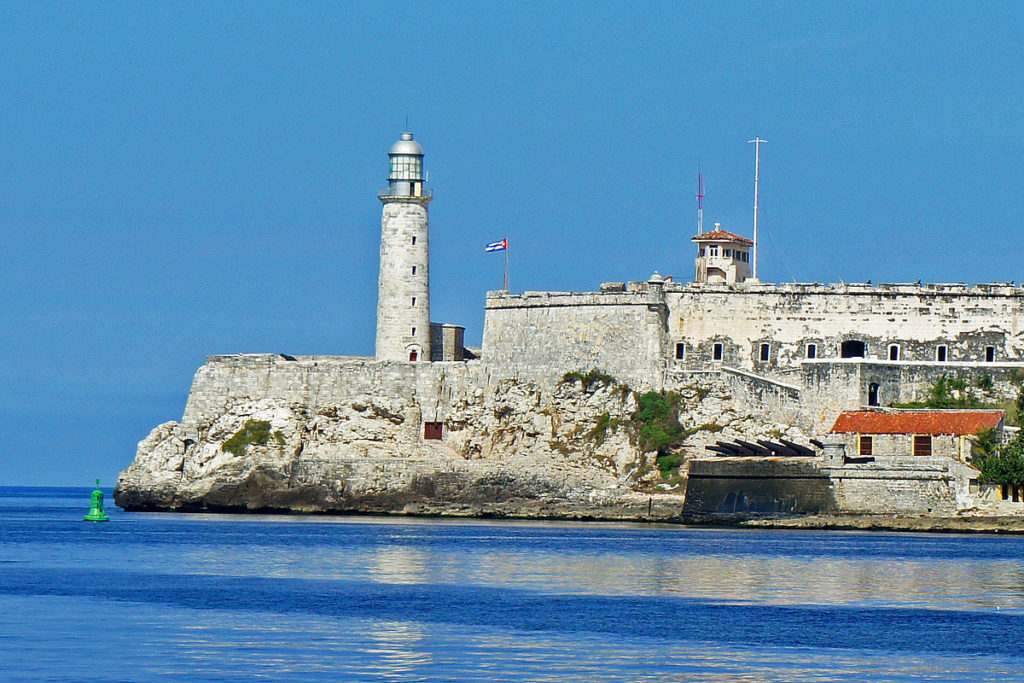 THE TOWER AND LIGHTHOUSE OF THE CASTLE OF MORRO, HAVANA IS 175 YEARS OLD.
THE TOWER AND LIGHTHOUSE OF THE CASTLE OF MORRO, HAVANA IS 175 YEARS OLD.
Like the famous structure of the Statue of Liberty at the entrance to the port of New York, in Havana, the first thing you see when you enter its port is the Castillo del Morro and the lighthouse of its fortress.
A recognized symbol of the Cuban capital, the lighthouse is a faithful watchman of the access to the bay of the Havana port and was completed on June 21, 1845.
This lookout for the important roadstead is located on the walls of the Castillo de Los Tres Reyes Magos del Morro, an old Spanish fortress, has a range of 18 nautical miles, and emits two flashes of light every 15 seconds. Erected from ashlar masonry and 45 meters high above sea level, it replaced the old lime and stone lighthouse that used firewood as fuel.
It has two bodies, the first is seventy-six feet high and the rest is topped with a cornice where there is an iron balustrade, the base where the lantern and the dome rest.
Third, in welcoming arriving ships and travelers, it offers a brand new image with an octagonal metal dome with crystals specially designed to guide ships and planes.
Meanwhile, a 170-step spiral staircase leads to this sentinel, which exhibits an imposing and wonderful view of the Historic Center of Old Havana, and the changes of a city in full transformation 500 years after its foundation.
THE OLD HAVANA WATCHMAN.
From the first years of the town of San Cristóbal de La Habana, its neighbors valued the conditions of an existing elevation on the right bank of the bay, which they gave the name of “El Morro”, to place lookouts there that they will announce the presence of enemy ships.
More effectively than from the opposite bank, from El Morro, you could see a wider area of the sea, as well as the entire coast to the east, on the other side of the hill of La Cabaña.
This defensive position of vigilance was highlighted in the session of the Havana Council of April 30, 1551, in which it was arranged that from the following day candles would be placed in the Morro, “as is customary … because there is news of Frenchmen.”
In order to make a better observation from that point, in 1563 Governor Diego de Mazariegos ordered to build in that place a tower of lime and stone, six and a half stadiums high and 15 stadiums above sea level, which would serve as a watchtower against pirates and corsairs since from there the view could be extended up to eight leagues away.
In 1762, the British attacked the island and the Morro lamppost was seriously damaged by artillery. After the recovery of the square by the Spanish in 1763, a lantern was erected in the Morillo bastion, named for having a small tower at the top, fed by firewood until the end of the 18th century.
In 1764, the castle tower began to be used as a lighthouse. At the beginning of the 19th century, they began to use gas to illuminate the lighthouse and, subsequently, oil, and in 1945, electric lighting was introduced in the Castillo del Morro.
This tower was demolished in 1844, building the current tower that recently reached its 175th anniversary.
Agencies/ RHC/ Guadalupe Yaujar/ Internet Photos/ Arnoldo Varona/ www.TheCubanHistory.com
THE CUBAN HISTORY, HOLLYWOOD.



